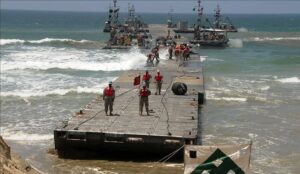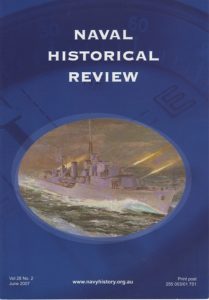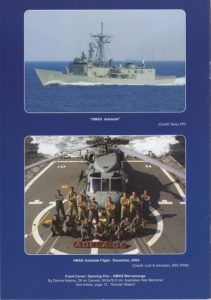- Author
- Editorial Staff
- Subjects
- History - general, Infrastructure and Facilities
- Tags
-
- RAN Ships
- None noted.
- Publication
- September 2024 edition of the Naval Historical Review (all rights reserved)
An Inspirational Beginning
Under a humanitarian aid initiative known as Joint Logistics Over The Shore (JLOTS), on Friday 17 May 2024 trucks began delivering shipments of humanitarian aid of food and other supplies over a United States-built floating pier to the embattled enclave of Gaza. The first delivery started at 9 am local time and when fully operational this was expected to build up to 150 trucks per day.
Known as the ‘Trident Pier’ it was assembled in modular form by the US military at the Israeli port of Ashdod, moved into position and anchored off the shore of Gaza earlier in May. The construction process took about two months and positioning was delayed by adverse weather. The whole JLOTS operation involved about 1000 US Army and Naval personnel. The pier is limited to operations in Sea State 3 and below.
Shortly after commissioning on Saturday 25 May a storm hit the pier causing four Army landing craft to break from the floating structure and drift inshore, two into Gaza and two further north into Israeli territory. In addition, part of the pier broke away from the main structure. The pier was temporarily closed and towed to Ashdod for repairs. There were no reports of injuries at that time but at least three persons had been injured during cargo operations, requiring hospitalisation. Thankfully repairs were soon completed and the pier was repositioned at Gaza on Friday 7 June 2024 and was back in operation the following day.
The pier helped overcome the closure on 7 May 2024 of the major Rafah crossing on the Egyptian border by Israeli forces, which had provided most of the aid to the 2.2 million people living in the 365 km2 Gaza Strip, which has one of the world’s highest population densities. The 550-metre-long pier operation is estimated to have cost $US320M.
Hundreds of tonnes of aid have arrived in Cyprus, some 400 km distant from Gaza, where it is screened and stored before loading into commercial ships for delivery to the new pier. However welcome, the Trident Pier does not replace a land crossing which also allowed for water and fuel to reach the enclave. The new pier also remains susceptible to terrorist attack.
The Trident Pier is based upon pontoon technology developed by the US Naval Construction Force, known as the ‘Seabees’, which first built a floating pier at Bora Bora in the Society Islands in February 1942. Similar structures were used throughout the Pacific and also used in the 1943 invasion of Sicily and then the June 1944 D-Day landings on the Normandy coast. The pontoon system was also used in the Korean and Vietnam wars.
The End is Nigh
While the military has helped deliver desperately needed food via the pier, the vast majority of it is still sitting in the adjacent storage yard and that area is almost full. Aid agencies have experienced difficulty moving the food to areas further into Gaza where it is most needed because the humanitarian convoys have frequently come under attack.
On June 9 the United Nations, which has the widest reach in delivering aid to starving Palestinians, ceased distributing food and other emergency supplies arriving through the pier. The pause came after the Israeli military used an area near the pier to fly out hostages after their rescue in a raid that killed more than 270 Palestinians, prompting a UN security review over concerns that the safety and neutrality of aid workers may have been compromised.

Humanitarian aid workers then started moving tonnes of aid piled up at the pier to warehouses in Gaza.
Heavy seas on Friday 28 June 2024 forced the military to again remove the pier for protection and it has been towed to the Israeli port of Ashdod. It is not known if the pier will be reinstalled. Media reports indicate that during the 42-day period from the start to finish of aid delivery the pier has only been operational for 16 days and delivered about 310 containers or 8000 tonnes of supplies.
On 12 July 2024 US authorities have confirmed the pier will now be disassembled and permanently removed. Consequently, aid supplies from Cyprus are now being shipped to Ashdod and transported by road to Gaza. It appears that there are many lessons to be learned from this operation.




